A New Load Frequency Control Technique for Hybrid Maritime Microgrids: Sophisticated Structure of Fractional-Order PIDA Controller
Abstract
1. Introduction
- This study proposes a new PIλDND2N2 controller for the LFC of a self-contained HMμGS, where the proposed controller structure is based on the combination of a PIDND2N2 controller and fractional-order integration.
- The proposed PIλDND2N2 controller is optimally designed using a reliable metaheuristic optimization algorithm, the GWO.
- The proficiency of the GWO algorithm is checked against other powerful optimization techniques that were extensively researched: ant lion optimization (ALO) and PSO.
- For assessing the performance of the suggested controller, the utilized PIλDND2N2 controller’s performance is compared to the performances of other controllers used in the literature under load/RESs fluctuations.
- Finally, the proposed controller allows the power system to mitigate the random load variations and intermittent fluctuations that occur in renewable energy power. As a result, the system stability increases, which significantly reduces overshooting and minimizes the settling time and rise time of the system.
2. System Modeling
2.1. Archimedes Wave Power Generation (AWPG)
2.2. Wind-Driven Generation (WDG)
2.3. Marine Bio-Diesel Generator (MBG)
2.4. Solid Oxide Electrolyte Fuel Cell (SOFC)
2.5. Non-Sensitive Loads (Heat Pump (HP) and Freezer (FRZ))
2.6. Dynamic Model of the Proposed HMGS
3. Proposed Control Methodology and Objective Function
3.1. Controller Structure
3.2. Formulation of the Objective Function (J)
- Enabling the RESs to produce the maximum possible power by utilizing their converters/interfacing devices;
- Controlling the extracted power from dispatchable units (SOFC and MBG);
- Controlling the input power of thermostatic non-sensitive loads (HP and FRZ).
4. Overview of the Gray Wolf Optimization (GWO) Algorithm
5. Results of the Simulation and Discussion
6. Conclusions
Author Contributions
Funding
Data Availability Statement
Acknowledgments
Conflicts of Interest
Nomenclature
| AESs | All-Electric Ships |
| AGC | Automatic Generation Control |
| ALO | Ant Lion Optimization |
| AWPG | Archimedes Wave Power Generation |
| BOA | Butterfly Optimization Algorithmic |
| CS | Cuckoo Search |
| ESSs | Energy Storage Systems |
| FA | Firefly Algorithm |
| FO | Fractional Order |
| FOPID | Fractional Order Proportional–Integral–Derivative |
| FPA | Flower Pollination Algorithm |
| FRZ | Freezers |
| GA | Genetic Algorithm |
| GOA | Grasshopper Optimization Algorithmic |
| GWs | Gray Wolves |
| GWO | Gray Wolf Optimizer |
| HMμGS | Hybrid Maritime Microgrid System |
| HP | Heat Pump |
| IPS | Integrated Power System |
| ITAE | Integral Time Absolute Error |
| LFC | Load Frequency Control |
| LMI | Linear Matrix Inequality |
| MBA | Mine Blast Algorithm |
| MBG | Marine Bio-diesel Generator |
| MµG | Maritime Microgrid |
| MOS | Maximum Overshoot |
| MUS | Maximum Under Shoot |
| NOPID | Non-integer Order Proportional–Integral–Derivative |
| PI | Proportional–Integral |
| PID | Proportional–Integral–Derivative |
| PI-(1 + PD) | PI-one plus Proportional–Derivative |
| PIDND2N2 | Proportional–Integral–Derivative with low-pass filter-derivative with two low-pass filter controllers |
| PIλDND2N2 | PIDND2N2 controller with fractional order integration |
| PMSG | Permanent Magnet Synchronous Generator |
| PSO | Particle Swarm Optimization |
| RESs | Renewable Energy Sources |
| SOFC | Solid Oxide Fuel Cell |
| SPS | Shipboard Power Systems |
| SMES | Superconducting Magnetic Energy Storage systems |
| WDG | Wind-Driven Generation |
| WTs | Wind Turbines |
| Valve Regulator Gain | |
| Combustion Engine Gain | |
| Time delay of Valve Regulator (s) | |
| constant Time of Combustion Engine (s) | |
| WDG gain | |
| WDG Time constant (s) | |
| AWPG gain | |
| AWPG Time constant(s) | |
| SOFC gain | |
| SOFC Time constant (s) | |
| HP gain | |
| HP Time constant (s) | |
| FRZ gain | |
| FRZ Time constant (s) | |
| M | Moment of inertia of HMG (s) |
| D | Damping co-factor of HMGS (p.u./Hz) |
| Velocity of floater-generator set (m/s) | |
| Floater-translator set movement (m) | |
| Wave strengths (N) | |
| Overall mass (kg) | |
| Damping factor of synchronous generator (N s/m) | |
| Damping factor of AWPG (N s/m) | |
| Spring coefficient (N/m) | |
| Magnitude of wave strength | |
| Radial frequency of wave strength | |
| Air density (Kg/m3) | |
| Radius of turbine (m) | |
| Wind speed (m/s) | |
| Extractable power coefficient of WT | |
| Tip speed ratio | |
| Pitch angle | |
| Change in input error of MBG | |
| Output control signal of the controller |
References
- Net Zero by 2050 A Roadmap for the Global Energy Sector; International Energy Agency: Paris, France, 2021.
- Marine Power Systems. Available online: https://www.marinepowersystems.co.uk/marine-energy/ (accessed on 17 March 2022).
- Guerrero, J.M.; Jin, Z.; Liu, W.; Othman, M. Shipboard Microgrids: Maritime Islanded Power Systems Technologies. In Proceedings of the International Exhibition and Conference for Power Electronics, Intelligent Motion, Renewable Energy and Energy Management, Aalborg, Denmark, 28–30 June 2016. [Google Scholar]
- Thongam, J.s.; Tarbouchi, M.; Okou, A.F.; Bouchard, D.; Beguenane, R. All-Electric Ships-A Review of the Present State of the Art. In Proceedings of the IEE, Eighth International Conference and Exhibition on Ecological Vehicles and Renewable Energies (EVER), Monte Carlo, Monaco, 27–30 March 2013. [Google Scholar]
- Latif, A.; Hussain, S.M.S.; Das, D.C.; Ustun, T.S. Double stage controller optimization for load frequency stabilization in hybrid wind-ocean wave energy based maritime microgrid system. Appl. Energy 2020, 282, 116171. [Google Scholar] [CrossRef]
- Maleki, A.; Askarzadeh, A. Optimal sizing of a PV/wind/diesel system with battery storage for electrification to an off-grid remote region: A case study of Rafsanjan, Iran. Sustain. Energy Technol. Assess. 2014, 7, 147–153. [Google Scholar] [CrossRef]
- Lan, H.; Wen, S.; Hong, Y.-Y.; Yu, D.C.; Zhang, L. Optimal sizing of hybrid PV/diesel/battery in ship power system. Appl. Energy 2015, 158, 26–34. [Google Scholar] [CrossRef]
- Maleki, A.; Askarzadeh, A. Artificial bee swarm optimization for optimum sizing of a stand-alone PV/WT/FC hybrid system considering LPSP concept. Sol. Energy 2014, 107, 227–235. [Google Scholar] [CrossRef]
- Haseltalab, A.; Wani, F.; Negenborn, R.R. Multi-level model predictive control for all-electric ships with hybrid power generation. Int. J. Electr. Power Energy Syst. 2022, 135, 107484. [Google Scholar] [CrossRef]
- Caravella, T.; Austell, C.; Brady-Alvarez, C.; Elsaiah, S. Hybrid Maritime Microgrids: A Quest for Future Onboard Integrated Marine Power Systems. In Innovation in Energy Systems—New Technologies for Changing Paradigms; IntechOpen: Rijeka, Croatia, 2019. [Google Scholar] [CrossRef]
- Othman, M.; Anvari-Moghaddam, A.; Guerrero, J.M. Hybrid shipboard microgrids: System architectures and energy management aspects. In Proceedings of the IECON 2017—43rd Annual Conference of the IEEE Industrial Electronics Society, Beijing, China, 29 October–1 November 2017; pp. 6801–6806. [Google Scholar] [CrossRef]
- Magdy, G.; Shabib, G.; Elbaset, A.A.; Mitani, Y. Renewable Power Systems Dynamic Security. Power Syst. 2020, 44, 1–13. [Google Scholar] [CrossRef]
- Magdy, G.; Shabib, G.; Elbaset, A.A.; Mitani, Y. A Novel Coordination Scheme of Virtual Inertia Control and Digital Protection for Microgrid Dynamic Security Considering High Renewable Energy Penetration. In IET Renewable Power Generation; Institution of Engineering and Technology (IET): London, UK, 2019; Volume 54513, pp. 462–474. [Google Scholar] [CrossRef]
- Alhelou, H.H.; Hamedani-Golshan, M.-E.; Zamani, R.; Heydarian-Forushani, E.; Siano, P. Challenges and Opportunities of Load Frequency Control in Conventional, Modern and Future Smart Power Systems: A Comprehensive Review. Energies 2018, 11, en11102497. [Google Scholar] [CrossRef]
- Das, D.C.; Roy, A.K.; Sinha, N. GA based frequency controller for solar thermal–diesel–wind hybrid energy generation/energy storage system. Int. J. Electr. Power Energy Syst. 2012, 43, 262–279. [Google Scholar] [CrossRef]
- Das, D.C.; Sinha, N.; Roy, A.K. Automatic Generation Control of an Organic Rankine Cycle Solar-Thermal/Wind-Diesel Hybrid Energy System. Energy Technol. 2014, 2, 721–731. [Google Scholar] [CrossRef]
- Kumar, M.; Hote, Y.V. Robust IMC-PIDA Controller Design for Load Frequency Control of a Time delayed Power System. In Proceedings of the IEEE 58th Conference on Decision and Control (CDC), Nice, France, 1 December 2019; pp. 8380–8385. [Google Scholar] [CrossRef]
- Nour, M.; Magdy, G.; Chaves-Ávila, J.P.; Sánchez-Miralles, Á.; Jurado, F. A new two-stage controller design for frequency regulation of low-inertia power system with virtual synchronous generator. J. Energy Storage 2023, 62, 106952. [Google Scholar] [CrossRef]
- Zaid, S.A.; Bakeer, A.; Magdy, G.; Albalawi, H.; Kassem, A.M.; El-Shimy, M.E.; AbdelMeguid, H.; Manqarah, B. A New Intelligent Fractional-Order Load Frequency Control for Interconnected Modern Power Systems with Virtual Inertia Control. Fractal Fract. 2023, 7, 62. [Google Scholar] [CrossRef]
- Bakeer, A.; Magdy, G.; Chub, A.; Jurado, F.; Rihan, M. Optimal Ultra-Local Model Control Integrated with Load Frequency Control of Renewable Energy Sources Based Microgrids. Energies 2022, 15, 9177. [Google Scholar] [CrossRef]
- Latif, A.; Das, D.C.; Barik, A.K.; Ranjan, S. Maiden co-ordinated load frequency control strategy for ST-AWEC-GEC-BDDG based independent three-area interconnected microgrid system with the combined effect of diverse energy storage and DC link using BOA optimized PFOID controller. IET Renew. Power Gener. 2019, 13, 2634–2646. [Google Scholar] [CrossRef]
- Magdy, G.; Bakeer, A.; Alhasheem, M. Robust decentralized model predictive load-frequency control design for time-delay renewable power systems. Int. J. Emerg. Electr. Power Syst. 2021, 22, 617–628. [Google Scholar] [CrossRef]
- Chen, M.-R.; Zeng, G.-Q.; Dai, Y.-X.; Lu, K.-D.; Bi, D.-Q. Fractional-Order Model Predictive Frequency Control of an Islanded Microgrid. Energies 2019, 12, 84. [Google Scholar] [CrossRef]
- Nosratabadi, S.M.; Bornapour, M.; Gharaei, M.A. Grasshopper optimization algorithm for optimal load frequency control considering predictive Functional Modified PID controller in restructured multi-resource multi-area power system with Redox Flow Battery units. Control Eng. Pract. 2019, 89, 204–227. [Google Scholar] [CrossRef]
- Guo, J. Application of a novel adaptive sliding mode control method to the load frequency control. Eur. J. Control 2020, 2020, 172–178. [Google Scholar] [CrossRef]
- Jalali, N.; Razmi, H.; Doagou-Mojarrad, H. Optimized fuzzy self-tuning PID controller design based on Tribe-DE optimization algorithm and rule weight adjustment method for load frequency control of interconnected multi-area power systems. Appl. Soft Comput. 2020, 93, 106424. [Google Scholar] [CrossRef]
- Shang-Guan, X.; He, Y.; Zhang, C.; Jiang, L.; Spencer, J.W.; Wu, M. Sampled-data based discrete and fast load frequency control for power systems with wind power. Appl. Energy 2020, 259, 114202. [Google Scholar] [CrossRef]
- Vafamand, N.; Khooban, M.H.; Dragicevic, T.; Boudjadar, J.; Asemani, M.H. Time-delayed stabilizing secondary load frequency control of shipboard microgrids. IEEE Syst. J. 2019, 13, 3233–3241. [Google Scholar] [CrossRef]
- Khooban, M.-H.; Dragicevic, T.; Blaabjerg, F.; Delimar, M. Shipboard Microgrids: A Novel Approach to Load Frequency Control. IEEE Trans. Sustain. Energy 2018, 9, 843–852. [Google Scholar] [CrossRef]
- Khooban, M.-H.; Gheisarnejad, M.; Vafamand, N.; Jafari, M.; Mobayen, S.; Dragicevic, T.; Boudjadar, J. Robust Frequency Regulation in Mobile Microgrids: HIL Implementation. IEEE Syst. J. 2019, 13, 4281–4291. [Google Scholar] [CrossRef]
- Ranjan, S.; Das, D.C.; Latif, A.; Sinha, N. LFC for autonomous hybrid microgrid system of 3 unequal renewable areas using mine blast algorithm. Int. J. Renew. Energy Res. 2018, 8, 1297–1308. [Google Scholar]
- Latif, A.; Pramanik, A.; Das, D.C.; Hussain, I.; Ranjan, S. Plug in hybrid vehicle-wind-diesel autonomous hybrid power system: Frequency control using FA and CSA optimized controller. Int. J. Syst. Assur. Eng. Manag. 2018, 9, 1147–1158. [Google Scholar] [CrossRef]
- Hussain, I.; Ranjan, S.; Das, D.C.; Sinha, N. Performance Analysis of Flower Pollination Algorithm Optimized PID Controller for Wind-PV-SMES-BESS-Diesel Autonomous Hybrid Power System. Int. J. Renew. Energy Res. 2017, 7, 643–651. [Google Scholar]
- Latif, A.; Suhail Hussain, S.M.; Das, D.C.; Ustun, T.S. State-of-the-art of controllers and soft computing techniques for regulated load frequency management of single/multi-area traditional and renewable energy based power systems. Appl. Energy 2020, 266, 114858. [Google Scholar] [CrossRef]
- Mirjalili, S.S.; Mirjalili, M.; Lewis, A. Grey wolf optimizer. Adv. Eng. Softw. 2014, 69, 46–61. [Google Scholar] [CrossRef]
- Hasanien, M.H. Whale optimisation algorithm for automatic generation control of interconnected modern power systems including renewable energy sources. IET Gener. Transm. Distrib. 2018, 12, 607–614. [Google Scholar] [CrossRef]
- Rihan, M.; Nasrallah, M.; Hasanin, B. Performance analysis of grid-integrated brushless doubly fed reluctance generator-based wind turbine: Modelling, control and simulation. SN Appl. Sci. 2020, 2, 114. [Google Scholar] [CrossRef]
- Lee, D.-J.; Wang, L. Small-Signal Stability Analysis of an Autonomous Hybrid Renewable Energy Power Generation/Energy Storage System Part I: Time-Domain Simulations. IEEE Trans. Energy Convers. 2008, 23, 311–320. [Google Scholar] [CrossRef]
- El-Fergany, A.A.; El-Hameed, M.A. Efficient frequency controllers for autonomous two-area hybrid microgrid system using social-spider optimizer. IET Gener. Transm. Distrib. 2017, 11, 637–648. [Google Scholar] [CrossRef]
- Podlubny, I. Fractional-order systems and fractional-order controllers. In Proceedings of the International Conference of Francophone d’Automatique, Grenoble, France, 19–23 September 1994. [Google Scholar]
- Morsali, J.; Zare, K.; Tarafdar Hagh, M. Applying fractional order PID to design TCSC-based damping controller in coordination with automatic generation control of interconnected multi-source power system. Eng. Sci. Technol. Int. J. 2017, 20, 1–17. [Google Scholar] [CrossRef]
- Oustaloup, A.; Levron, F.; Mathieu, B.; Nanot, F.M. Frequency-band complex noninteger differentiator: Characterization and synthesis. In IEEE Transactions on Circuits and Systems I: Fundamental Theory and Applications; IEEE: New York, NY, USA, 2000; Volume 47, pp. 25–39. [Google Scholar] [CrossRef]
- Moschos, I.; Parisses, C. A novel optimal PIλDND2N2 controller using coyote optimization algorithm for an AVR system. Eng. Sci. Technol. Int. J. 2022, 26, 100991. [Google Scholar] [CrossRef]
- Agrawal, K.; Negi, R.; Singh, N. Dynamically tuned PIDD2 controller for single-link flexible manipulator. In Lecture Notes in Electrical Engineering; Springer: Singapore, 2019; pp. 907–924. [Google Scholar]
- Magdy, G.; Shabib, G.; Elbaset, A.A.; Mitani, Y. Renewable power systems dynamic security using a new coordination of frequency control strategy based on virtual synchronous generator and digital frequency protection. Int. J. Electr. Power Energy Syst. 2019, 109, 351–368. [Google Scholar] [CrossRef]
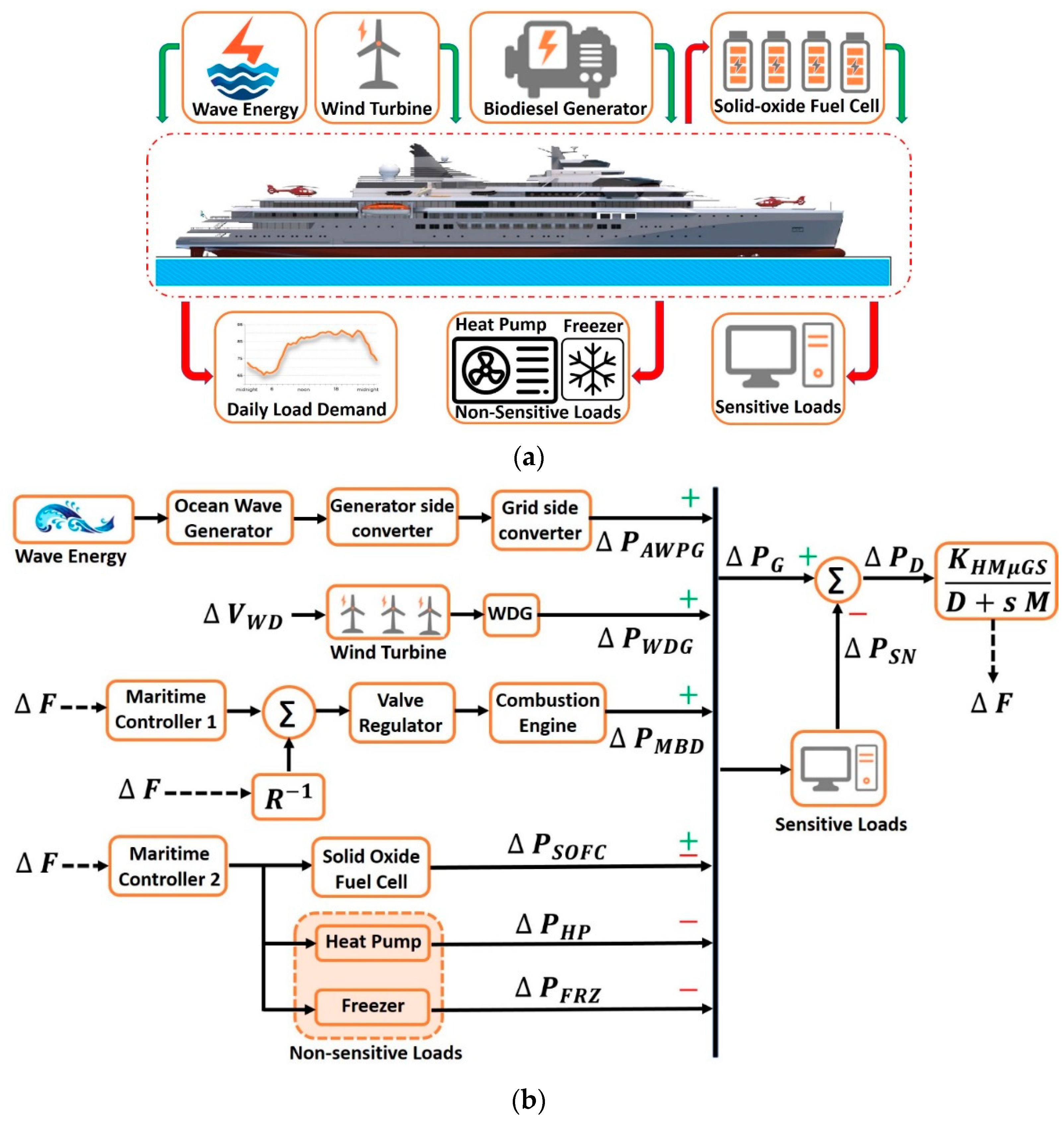

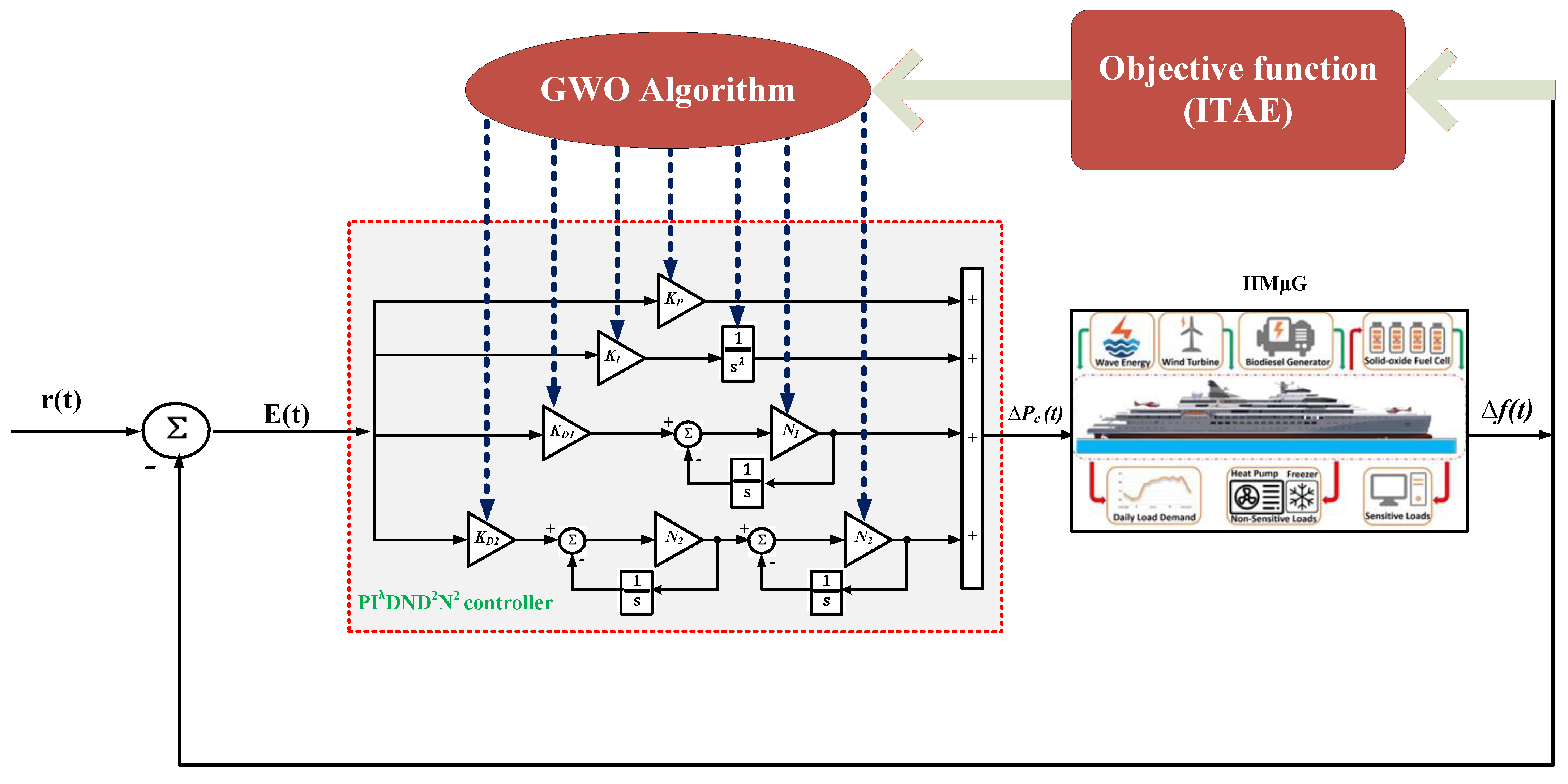

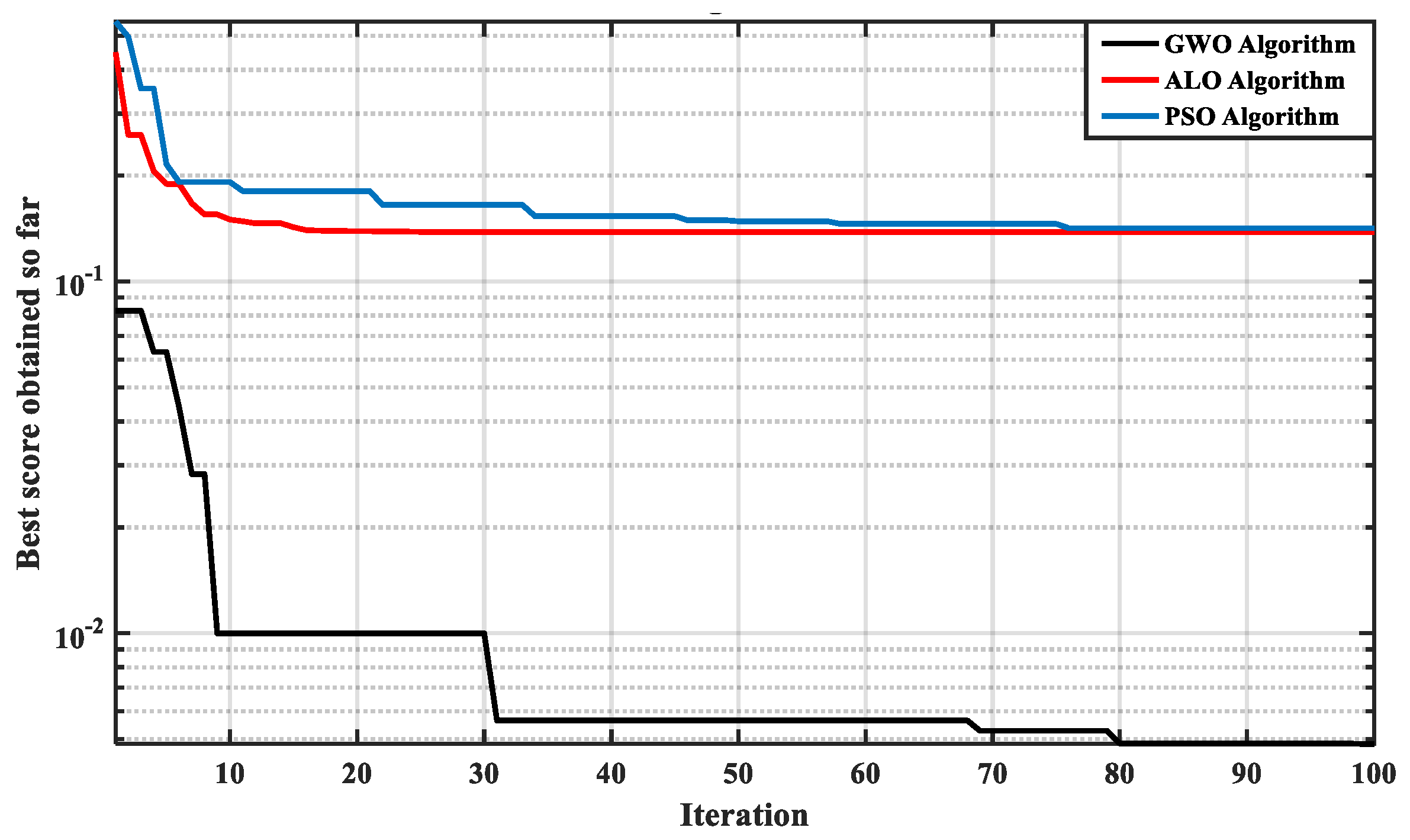

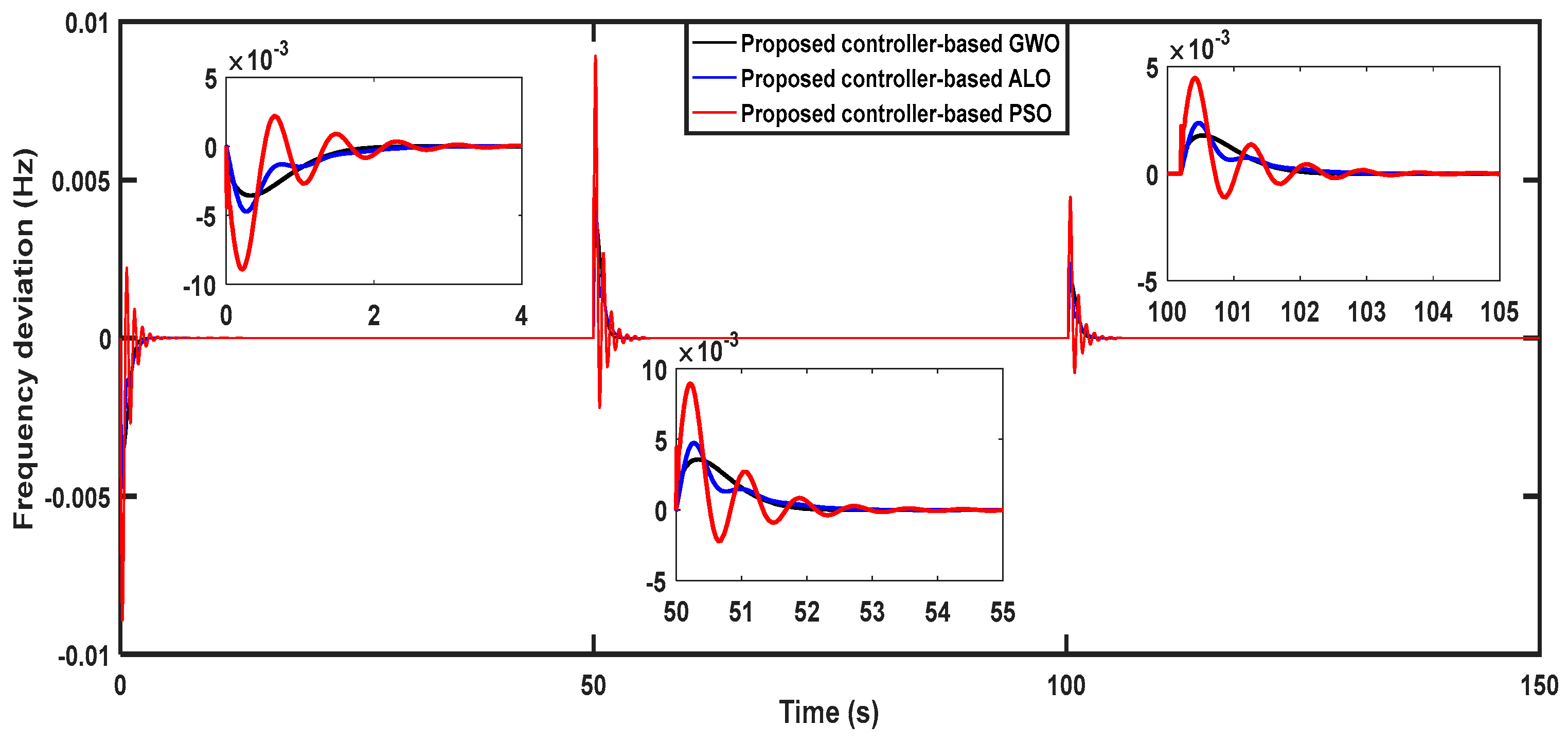
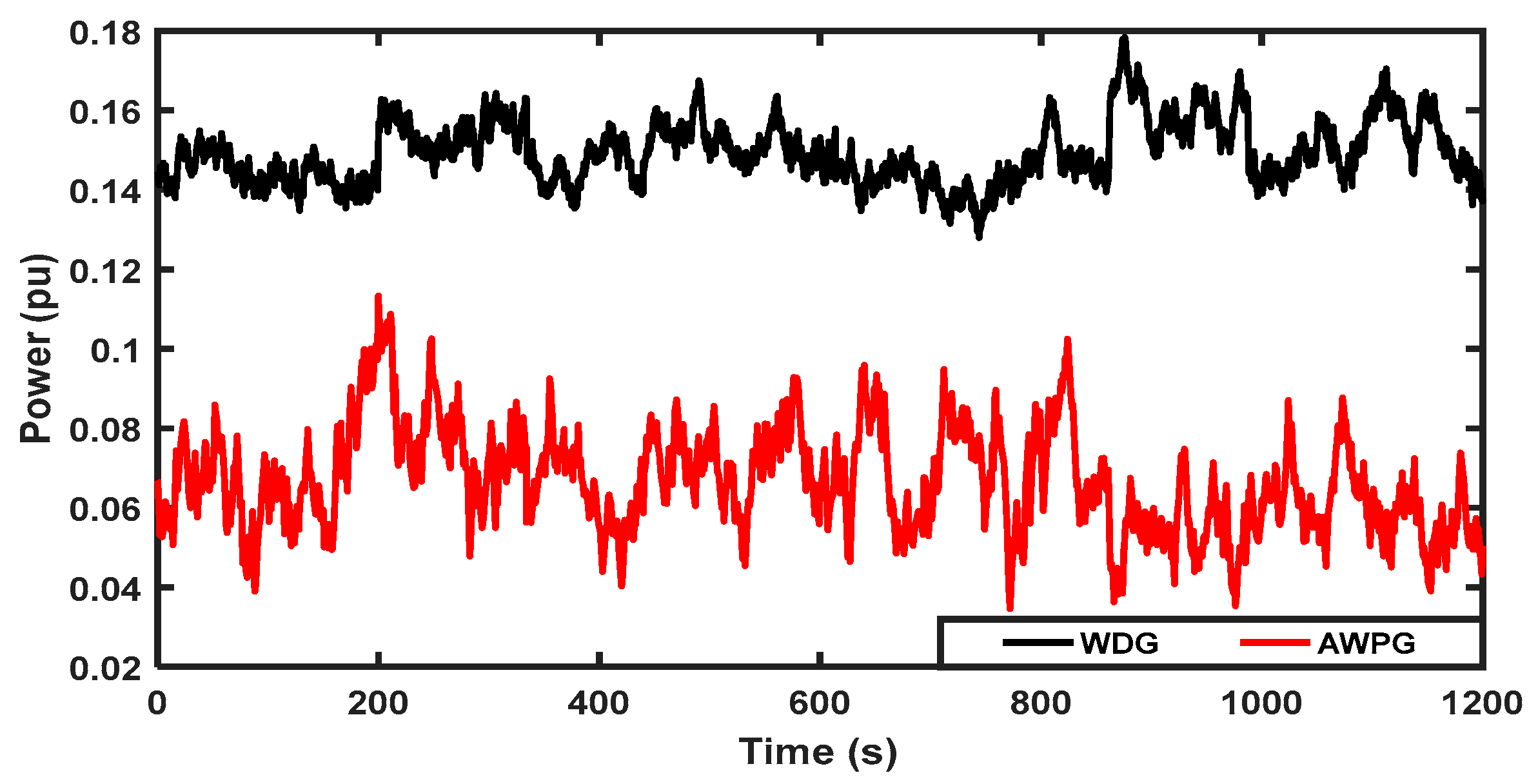
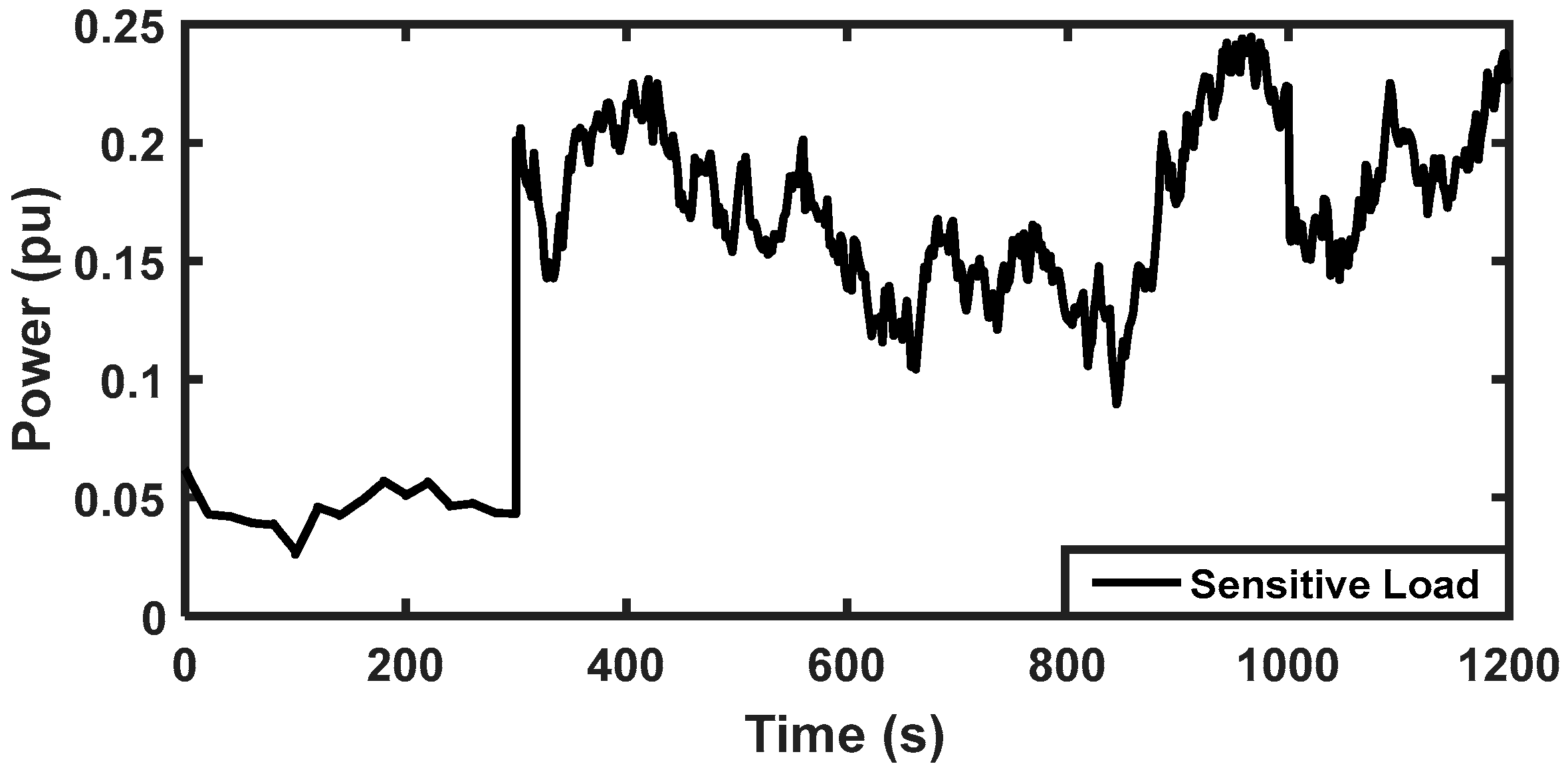

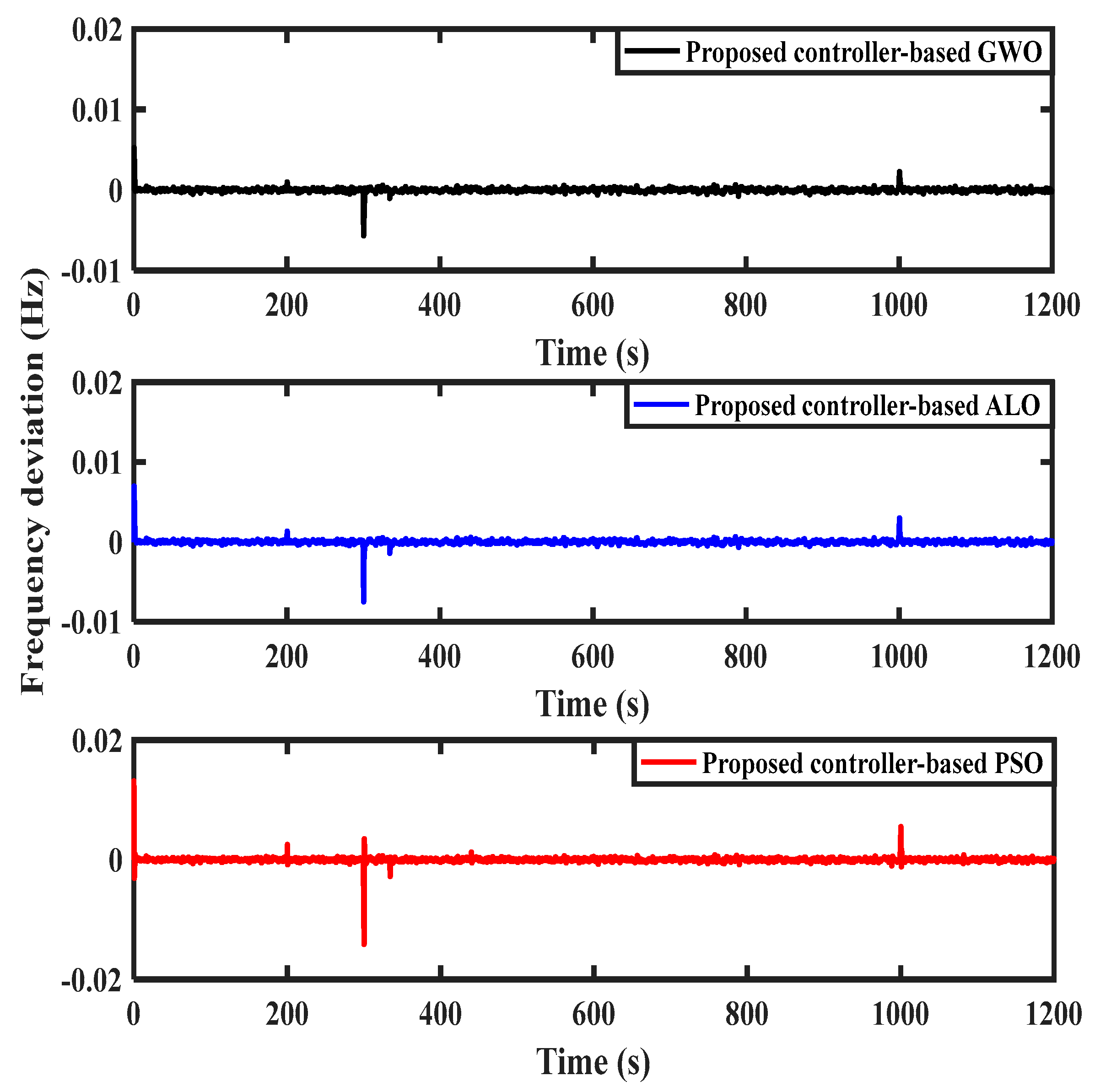


| Parameters | Value | Parameters | Value |
|---|---|---|---|
| 1.000 | 1.000 | ||
| 1.000 | 0.200 | ||
| 0.080 | 1.000 | ||
| 0.400 | 0.100 | ||
| 1.000 | 1.000 | ||
| 5.000 | 0.265 | ||
| 1.000 | M | 0.120 | |
| 0.300 | D | 1.000 |
| Parameter | PIλDND2N2 Controller-Based GWO (Proposed) | PIλDND2N2 Controller-Based ALO | PIλDND2N2 Controller-Based PSO | |
|---|---|---|---|---|
| Controller 1 | KP1 | 5.2761 | 6.9075 | 10 |
| KI1 | 8.6231 | 5.2305 | 0.1000 | |
| KD1-1 | 8.8277 | 1.9913 | 0.4634 | |
| KD2-1 | 0.0505 | 2.5289 | 0.1000 | |
| N1-1 | 519.9601 | 97.1532 | 50.0000 | |
| N2-1 | 103.6735 | 483.6617 | 647.7456 | |
| λ1 | 0.1190 | 0.1308 | 1.0033 | |
| Controller 2 | KP2 | 9.3471 | 9.5982 | 6.6812 |
| KI2 | 9.9671 | 10 | 10 | |
| KD1-2 | 2.6624 | 0.5318 | 0.1000 | |
| KD2-2 | 0.0724 | 0.2243 | 0.1000 | |
| N1-2 | 374.9135 | 350.5638 | 962.5905 | |
| N2-2 | 436.3411 | 413.2159 | 50.0000 | |
| λ2 | 1.0000 | 1.0000 | 1.0000 | |
| ITAE | 0.0048 | 0.1416 | 0.1372 | |
| Optimal Controller | MUS (Hz) | MOS (Hz) | TS (s) | |
|---|---|---|---|---|
| Case A | PIλDND2N2-GWO (Proposed) | 7.135 × 10−3 | 0.000 × 10−3 | 1.984 |
| PIλDND2N2- ALO | 9.402 × 10−3 | 0.000 × 10−3 | 3.018 | |
| PIλDND2N2-PSO | 17.850 × 10−3 | 4.447 × 10−3 | 5.050 | |
| Case B | PIλDND2N2-GWO (Proposed) | 3.556 × 10−3 | 3.566 × 10−3 | 1.857 |
| PIλDND2N2-ALO | 4.687 × 10−3 | 4.729 × 10−3 | 3.134 | |
| PIλDND2N2-PSO | 8.926 × 10−3 | 8.934 × 10−3 | 4.743 | |
| Case C | PIλDND2N2-GWO (Proposed) | 5.690 × 10−3 | 5.271 × 10−3 | 1.599 |
| PIλDND2N2-ALO | 7.509× 10−3 | 6.990 × 10−3 | 3.067 | |
| PIλDND2N2-PSO | 14.160 × 10−2 | 13.200 × 10−3 | 4.011 | |
| Parameter | PIλDND2N2 Controller-Based GWO (Proposed) | PID Controller-Based GWO | PID Controller-Based GOA [5] | |
|---|---|---|---|---|
| Controller 1 | KP1 | 5.2761 | 2.1759 | 0.526 |
| KI1 | 8.6231 | 4.2154 | 10.110 | |
| KD1-1 | 8.8277 | 9.9547 | 0.112 | |
| KD2-1 | 0.0505 | - | - | |
| N1-1 | 519.9601 | - | - | |
| N2-1 | 103.6735 | - | - | |
| λ1 | 0.1190 | - | - | |
| Controller 2 | KP2 | 9.3471 | 5.4278 | 5.014 |
| KI2 | 9.9671 | 8.4178 | 5.558 | |
| KD1-2 | 2.6624 | 2.8938 | 1.615 | |
| KD2-2 | 0.0724 | - | - | |
| N1-2 | 374.9135 | - | - | |
| N2-2 | 436.3411 | - | - | |
| λ2 | 1.0000 | - | - | |
| Optimal Controller | MUS (Hz) | MOS (Hz) | TS (s) | |
|---|---|---|---|---|
| Case A | PIλDND2N2-GWO (Proposed) | 7.137 × 10−3 | 0 | 2.128 |
| PID—GWO | 8.818 × 10−3 | 6.583 × 10−4 | 5.093 | |
| PID-GOA [5] | 9.773 × 10−3 | 0 | 6.036 | |
| Case B | PIλDND2N2-GWO (Proposed) | 5.609 × 10−3 | 5.279 × 10−3 | 1.716 |
| PID-GWO | 8.753 × 10−3 | 6.532 × 10−3 | 3.016 | |
| PID-GOA [5] | 9.187 × 10−3 | 7.114 × 10−3 | 6.027 | |
Disclaimer/Publisher’s Note: The statements, opinions and data contained in all publications are solely those of the individual author(s) and contributor(s) and not of MDPI and/or the editor(s). MDPI and/or the editor(s) disclaim responsibility for any injury to people or property resulting from any ideas, methods, instructions or products referred to in the content. |
© 2023 by the authors. Licensee MDPI, Basel, Switzerland. This article is an open access article distributed under the terms and conditions of the Creative Commons Attribution (CC BY) license (https://creativecommons.org/licenses/by/4.0/).
Share and Cite
Almasoudi, F.M.; Magdy, G.; Bakeer, A.; Alatawi, K.S.S.; Rihan, M. A New Load Frequency Control Technique for Hybrid Maritime Microgrids: Sophisticated Structure of Fractional-Order PIDA Controller. Fractal Fract. 2023, 7, 435. https://doi.org/10.3390/fractalfract7060435
Almasoudi FM, Magdy G, Bakeer A, Alatawi KSS, Rihan M. A New Load Frequency Control Technique for Hybrid Maritime Microgrids: Sophisticated Structure of Fractional-Order PIDA Controller. Fractal and Fractional. 2023; 7(6):435. https://doi.org/10.3390/fractalfract7060435
Chicago/Turabian StyleAlmasoudi, Fahad M., Gaber Magdy, Abualkasim Bakeer, Khaled Saleem S. Alatawi, and Mahmoud Rihan. 2023. "A New Load Frequency Control Technique for Hybrid Maritime Microgrids: Sophisticated Structure of Fractional-Order PIDA Controller" Fractal and Fractional 7, no. 6: 435. https://doi.org/10.3390/fractalfract7060435
APA StyleAlmasoudi, F. M., Magdy, G., Bakeer, A., Alatawi, K. S. S., & Rihan, M. (2023). A New Load Frequency Control Technique for Hybrid Maritime Microgrids: Sophisticated Structure of Fractional-Order PIDA Controller. Fractal and Fractional, 7(6), 435. https://doi.org/10.3390/fractalfract7060435









